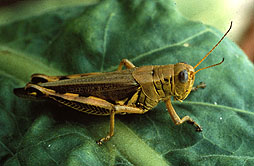This page has been archived and is being provided for reference purposes only. The page is no longer being updated, and therefore, links on the page may be invalid.
| Read the magazine story to find out more. |
|
|
New Fungi Could Curb Grasshopper Populations
By Stephanie YaoJanuary 6, 2011
Beneficial fungi that could help manage grasshopper populations are being tested by U.S. Department of Agriculture (USDA) scientists and university colleagues.
Entomologist Stefan Jaronski with USDA's Agricultural Research Service (ARS) at the agency's Northern Plains Agricultural Research Laboratory in Sidney, Mont., is working with university and USDA Animal and Plant Health Inspection Service scientists to evaluate several fungi that could be used as biocontrol agents against these hopping pests. ARS is USDA's principal intramural scientific research agency.
Every summer, growers, ranchers and pest control groups in the Western United States prepare for possible grasshopper and Mormon cricket infestations. The pests can eat the equivalent of their body weight daily in vegetation, leaving less grass for livestock. The insects also sometimes eat crops such as wheat and alfalfa, resulting in yield losses.
Jaronski and colleagues are currently evaluating three candidate fungi—Metarhizium robertsii DWR 346, M. robertsii DWR 356 and M. brunneum F52—that could be used to control the grasshopper and Mormon cricket populations. The first two fungi were discovered through an exploratory program led by Utah State University professor Don Roberts. Field tests that began last summer in Montana, Wyoming and Utah will help determine if the fungi are suitable biocontrol agents.
The researchers are awaiting permission to conduct field tests on another fungus named M. acridum, commonly known as "Green Muscle." The product was developed by CABI, an international, not-for-profit organization aimed at solving agricultural and environmental problems, and has been commercialized in Africa for locust control.
According to Jaronski, Green Muscle has many beneficial characteristics. The fungus only targets insects in the order Orthoptera, to which grasshoppers belong. It can also evade detection by the grasshopper's immune system and, if detected, can overcome the insect's natural defenses. And since only a few hundred spores of Green Muscle are needed to successfully infect a grasshopper, compared to the several thousand spores required for other fungi, users could significantly reduce their current pest control costs.
Read more about this research in the January 2011 issue of Agricultural Research magazine.

